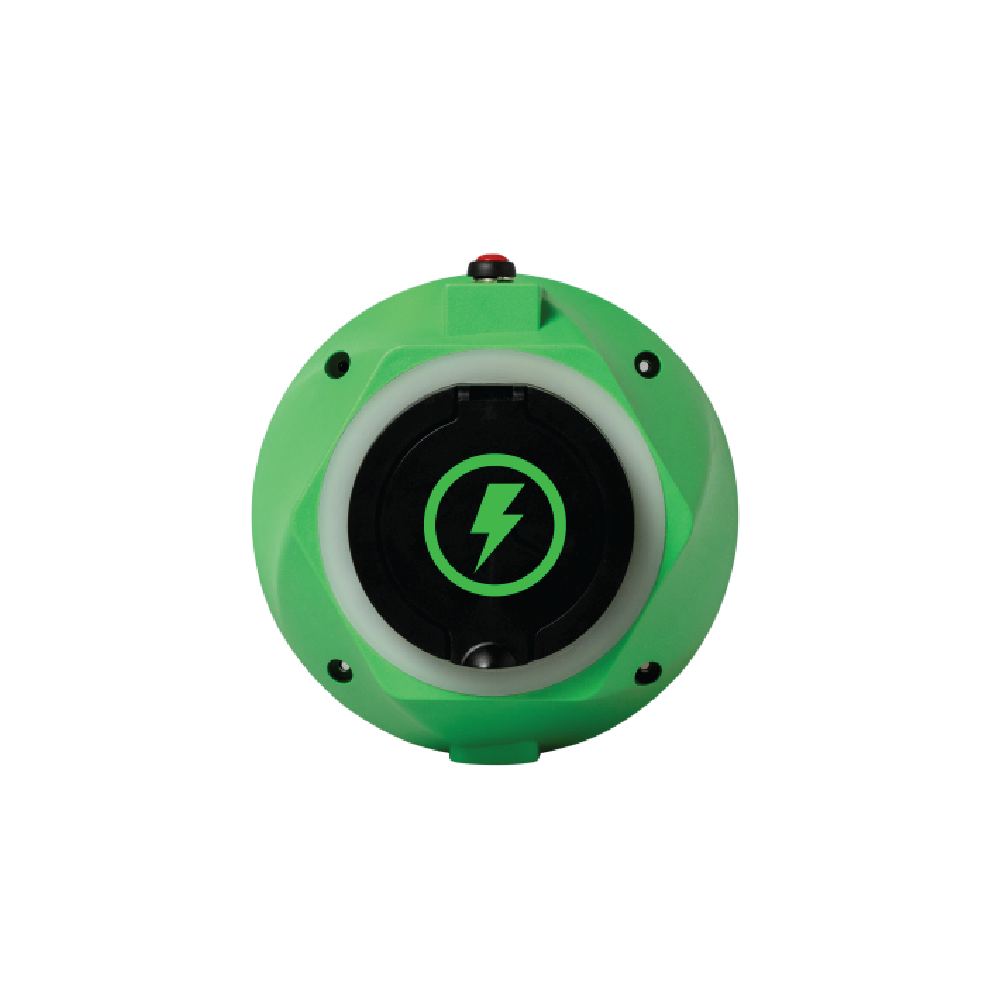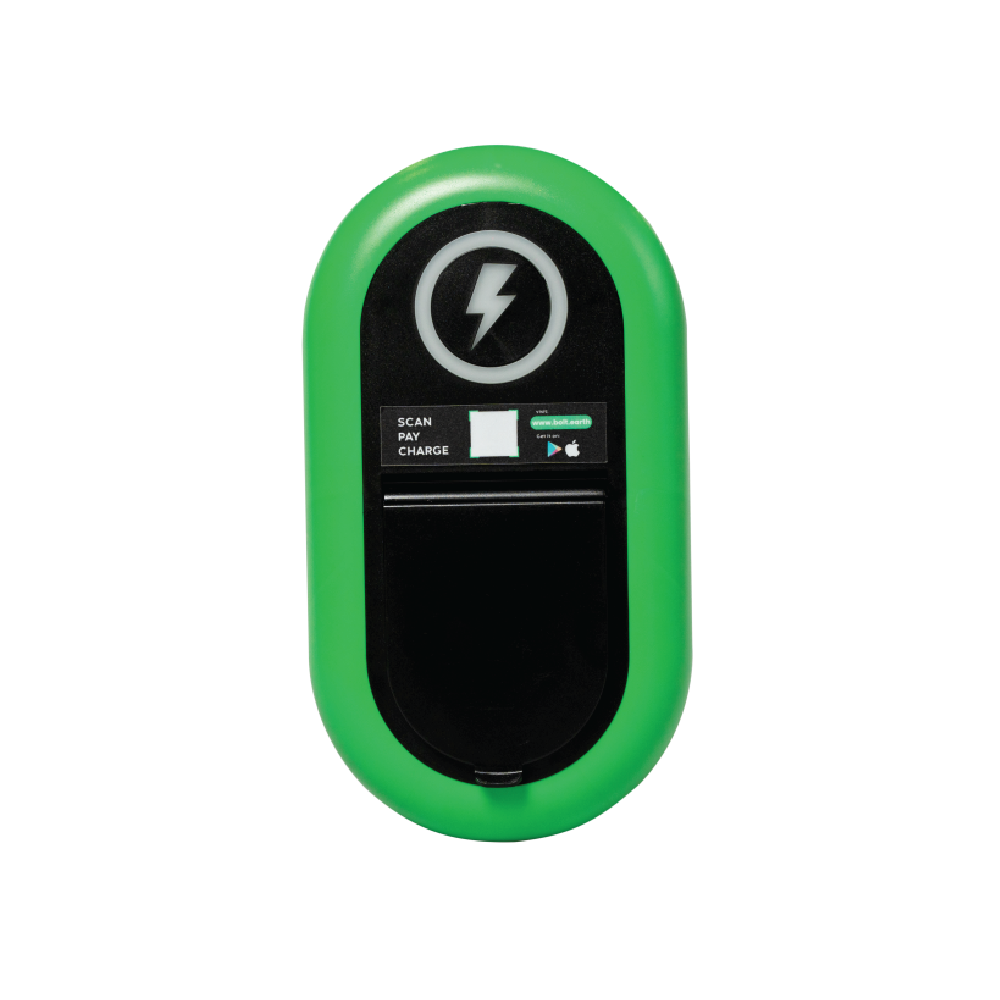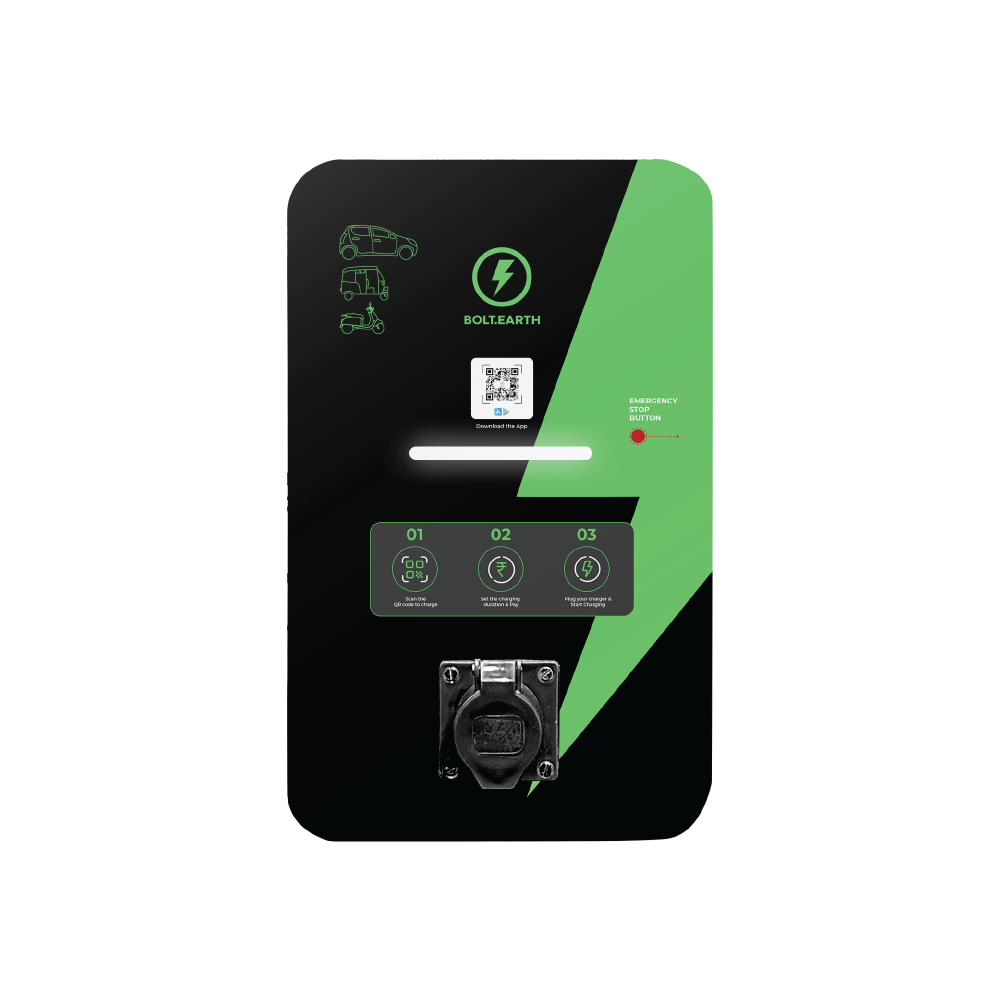DC Charging vs AC Charging for EVs: What Businesses Need to Know
Raghav Bharadwaj
Chief Executive Officer
Published on:
06 Oct, 2025
Updated on:
04 Dec, 2025

Choosing between DC vs AC EV charging is a critical decision. These two charging methods differ in terms of speed, cost, and use cases, and understanding the differences is key to developing a smart EV charging strategy for companies.
India’s EV charging infrastructure has expanded rapidly in recent years. Public and semi-public charging points grew from about 6,600 in early 2023 to nearly 29,300 by mid-2025. However, not all chargers are created equal: only about 35% are DC fast units, while the majority are slower AC chargers. Offering convenient charging can attract EV-driving customers, support employees with EVs, and future-proof your business for the electric mobility wave, especially if you’re planning a commercial EV charging station.
- This article will explore:
- The fundamental difference between AC and DC fast charging
- Pros and cons of AC vs. DC charging for businesses
- Which charging type suits different business scenarios in the Indian EV context
AC vs. DC Charging: The Basics
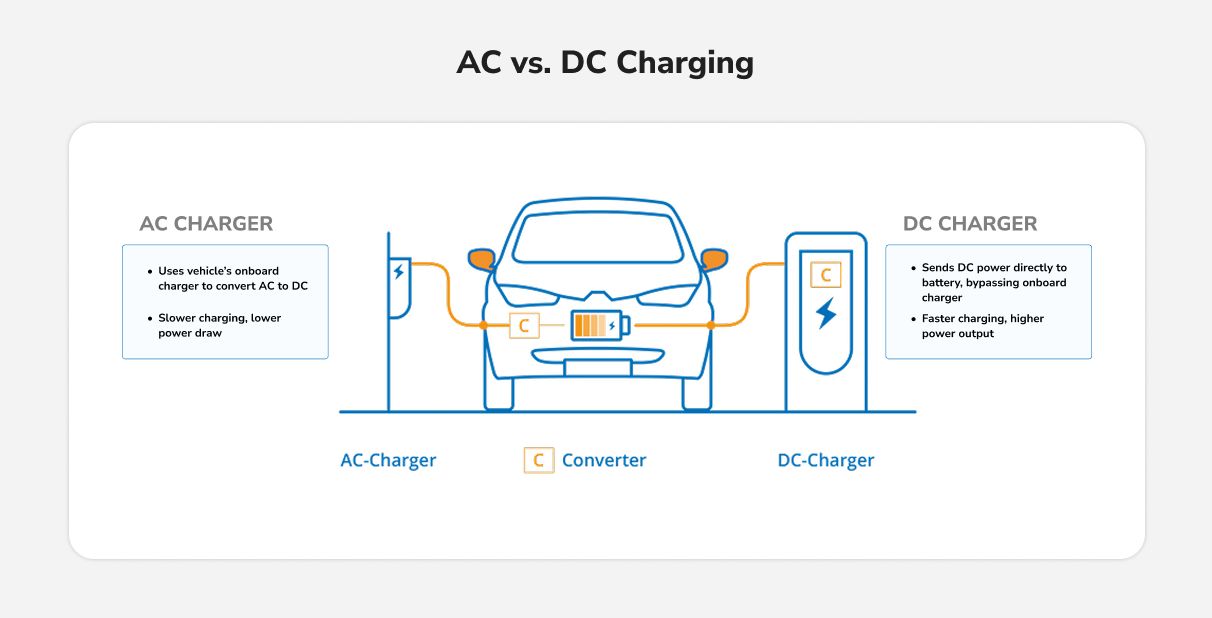
Fundamentally, the difference between AC and DC charging lies in where the AC power from the grid is converted into DC power that an EV’s battery can accept. In AC charging, the conversion occurs onboard the vehicle: the charger utilizes the car’s built-in converter to convert AC from the outlet into DC for the battery.
In DC fast charging, the conversion is handled by the high-powered charging station itself, which feeds DC electricity directly to the battery, bypassing the vehicle’s onboard charger. A helpful analogy is your laptop or phone charger brick. It converts AC from your wall socket to DC for your device’s battery. With AC charging, the EV essentially uses a “small brick” inside the car, whereas DC fast charging is like using an external supercharger that delivers battery-ready power instantly.
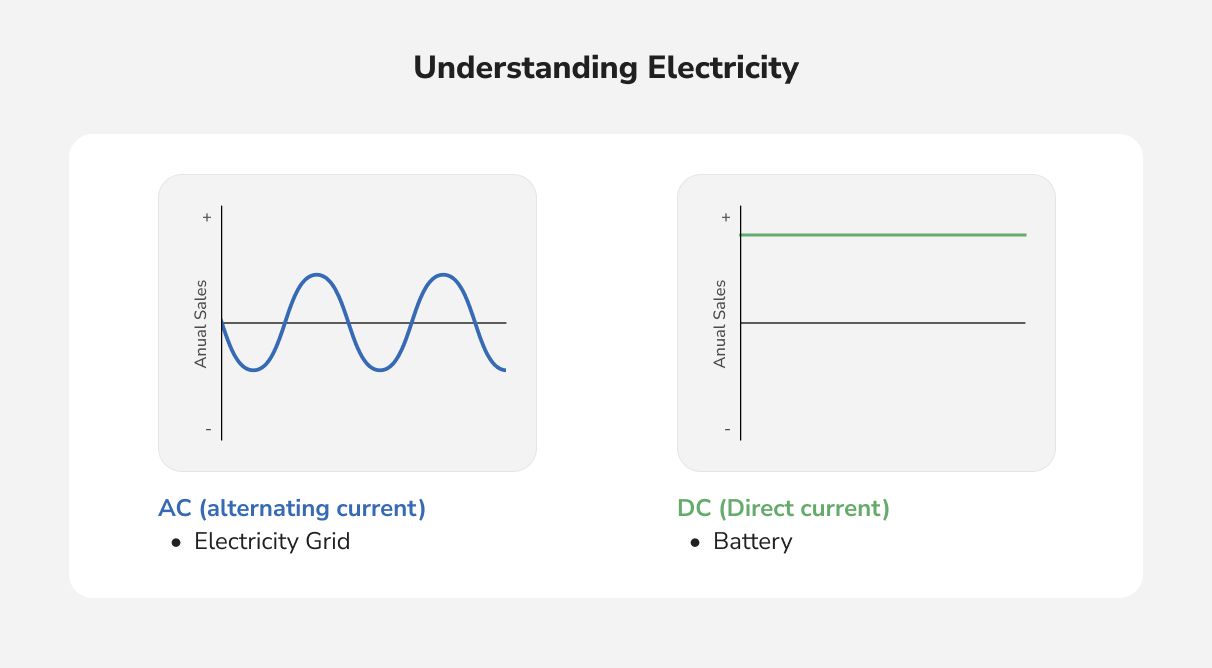
Practically, this means AC charging is slower and lower power, while DC charging is much faster but requires more powerful equipment. AC chargers typically provide 3 to 22 kW of power, translating to roughly 4–10 hours to fully charge a mid-size EV. DC fast chargers range from around 15 kW up to 160–360+ kW, allowing an EV to reach about 80% charge in just 20–60 minutes.
The car’s onboard charger capacity limits AC charging. Even if you plug into a high-rated AC charger, the vehicle may only draw what it can handle (often 3.3 kW or 7.2 kW for many models).
DC chargers bypass this limitation by feeding the battery directly, enabling much faster range addition. However, the intense power of DC fast charging generates more heat. Frequent use can strain the battery. Occasional fast charging is fine (modern EVs have thermal management systems), but over-reliance on DC charging may lead to slightly faster battery degradation. AC charging is gentler; lower currents are generally easier on the battery over time. This is a key consideration in AC vs DC charging for EVs.
AC Charging: Pros and Cons
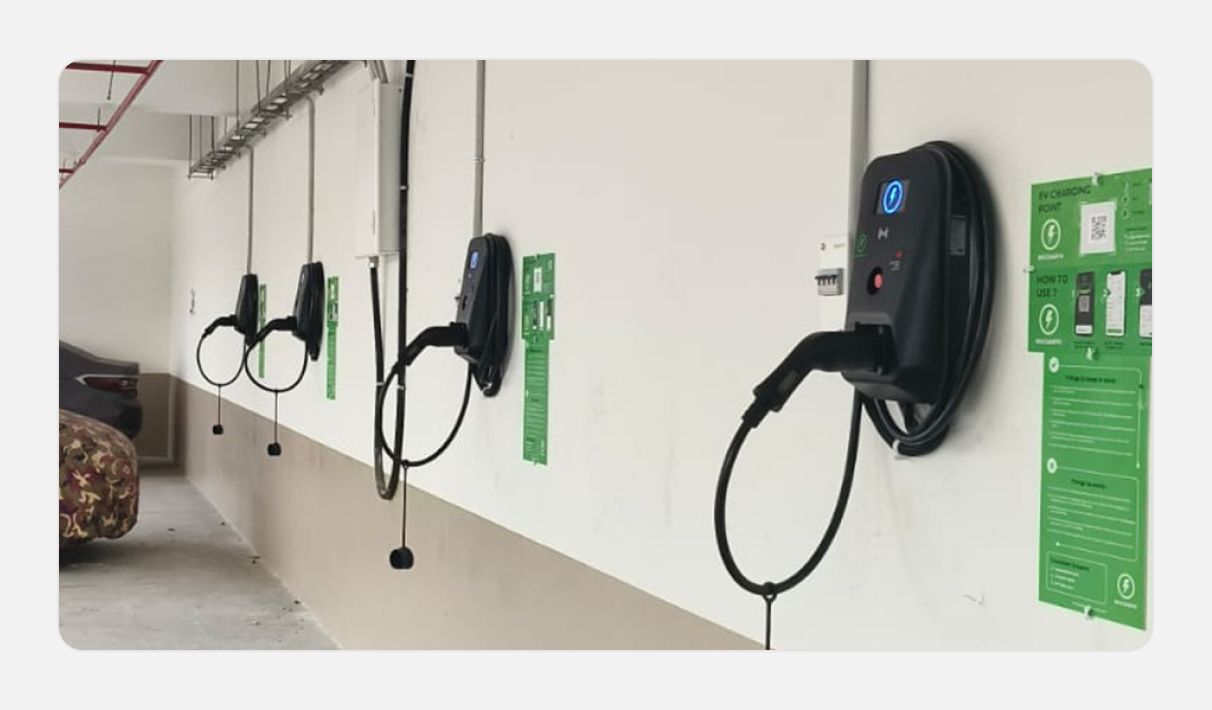
For businesses, AC charging offers several advantages along with some limitations:
Pros of AC Charging:
- Low equipment and installation cost: AC charging stations are relatively inexpensive and simple to install. A basic AC charger (wall-mounted unit or pedestal) typically costs much less than a DC fast charger. Small 3–7 kW units can even be modified into heavy-duty sockets or smart plugs. Installation usually requires standard electrical wiring, keeping capital costs low, ideal for a commercial EV charging station setup.
- Simpler electrical load management: AC chargers draw modest power (similar to an appliance or AC unit), making it easier to obtain utility/DISCOM approval and often avoiding expensive grid upgrades. Many businesses can integrate AC chargers without major changes to their existing electrical setup.
- Universal compatibility: Every EV on the market supports AC charging, as all have onboard AC chargers. This includes electric two-wheelers, three-wheelers, and high-end electric cars. With the appropriate connector, AC charging works across types, even models that lack fast-charging options.
Cons of AC Charging:
- Slower charging speeds: AC charging is significantly slower than a DC fast charger. A typical AC charger adds around 10–20 km of range per hour, which is suitable for overnight or all-day charging, but not for quick turnarounds. For high-turnover businesses like highway pit stops or taxi fleets, AC alone may not suffice.
- Limited by the vehicle’s onboard charger: The actual charging speed with AC is capped by the EV’s onboard charger. For instance, if a car’s onboard charger is 7.2 kW, even plugging into a 22 kW AC station won’t increase the speed; it will still charge at 7.2 kW. Upgrading the AC station beyond a certain point yields no benefit unless the vehicles can utilize it. This limitation can be a bottleneck, especially as battery sizes grow.
Despite the slower speed, AC chargers are ideal for scenarios where vehicles are parked for extended periods and cost is a major consideration. AC fast chargers can be a tactical part of an EV charging strategy for companies focused on long dwell times.,
DC Fast Charging: Pros and Cons
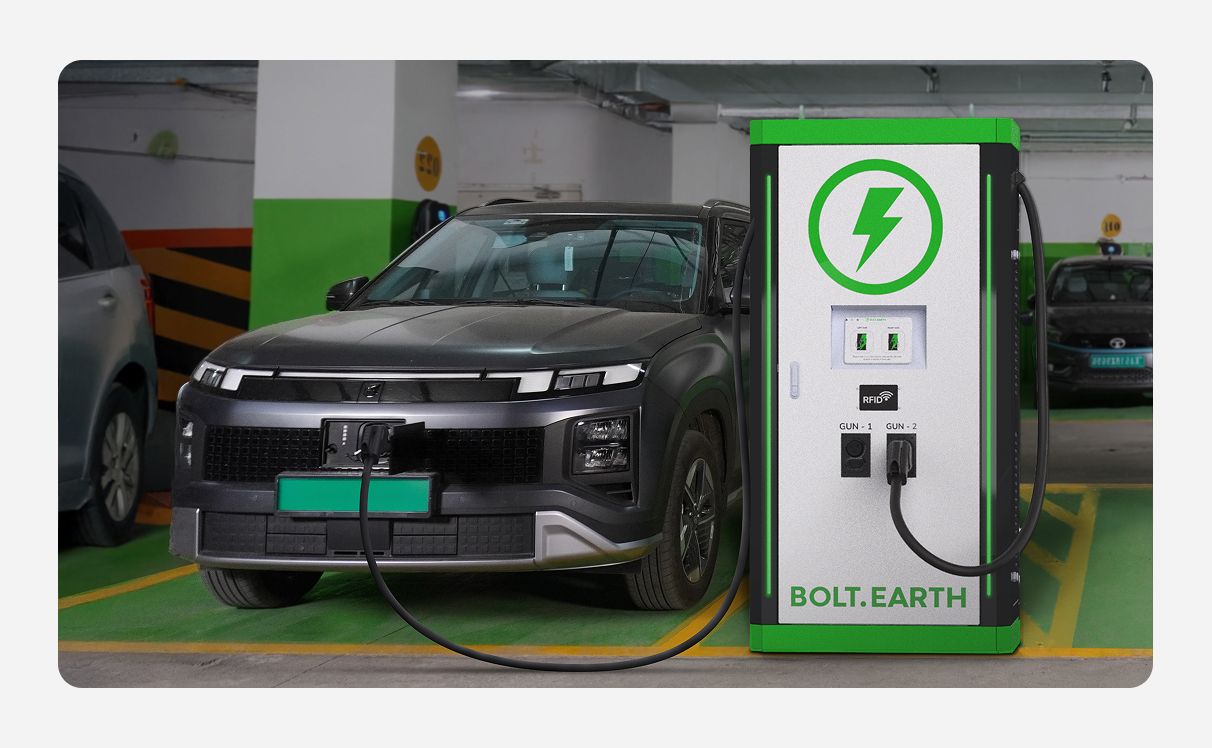
For businesses aiming to offer rapid charging or support vehicles needing quick turnarounds, DC chargers can be game changers, but they come with higher costs and infrastructure requirements.
Pros of DC fast Charging:
- Rapid charging for quick turnaround: The key advantage of DC charging is speed. High-power DC stations can deliver up to 80% charge in 30-40 minutes for compatible vehicles. This enables businesses to serve more EV drivers daily, boosting throughput and potentially increasing revenue or supporting time-sensitive operations.
- Support long-distance travel and larger vehicles: DC fast chargers are essential for intercity EV travel and are commonly installed at highway rest stops. They are also the only practical solution for charging large battery packs in electric buses, trucks, or long-range cars. With appropriate connectors, DC stations can accommodate heavy EVs, making them vital for fleet operators and public transport electrification.
- Not limited by onboard charger constraints: Since the conversion happens off-board, DC chargers aren’t restricted by the vehicle’s onboard AC charger. If an EV supports 100 kW DC, a compatible fast charger can deliver that. This makes DC infrastructure more “future-proof” for newer EVs with ultra-fast charging capabilities.
Cons of DC Fast Charging:
- High equipment and installation cost: DC fast chargers are significantly more expensive than AC units. They include powerful rectifiers, cooling systems, and advanced control electronics. A single DC fast charger can cost anywhere between ₹8–10 lakhs for a 15–30 kW unit and tens of lakhs for 50+ kW models. Ultra-fast stations (150 kW, 200 kW, etc.) can reach ₹50–80 lakh per unit. Installation is complex and often requires high-capacity grid connections, transformers, and heavy cabling.
- Greater power and infrastructure needs: While AC chargers can plug into standard supplies, DC fast charger requires large power feeds. For example, a 60 kW DC charger may need a dedicated 400 V, 3-phase line with a high sanctioned load. Not all sites have this readily available. Upgrading infrastructure (new transformers, substations, etc.) can be a major project. Adequate space and a cooling system are also necessary, which can extend the installation timeline and require coordination with electricity providers.
- Higher maintenance complexity: DC chargers involve advanced electronics and cooling systems, making them more maintenance-intensive. They are industrial-grade electrical devices that may require remote monitoring, regular servicing, and higher repair costs. Businesses must factor in operational expenses and possibly service contracts to ensure uptime.
Choosing the Right Charger for Different Scenarios
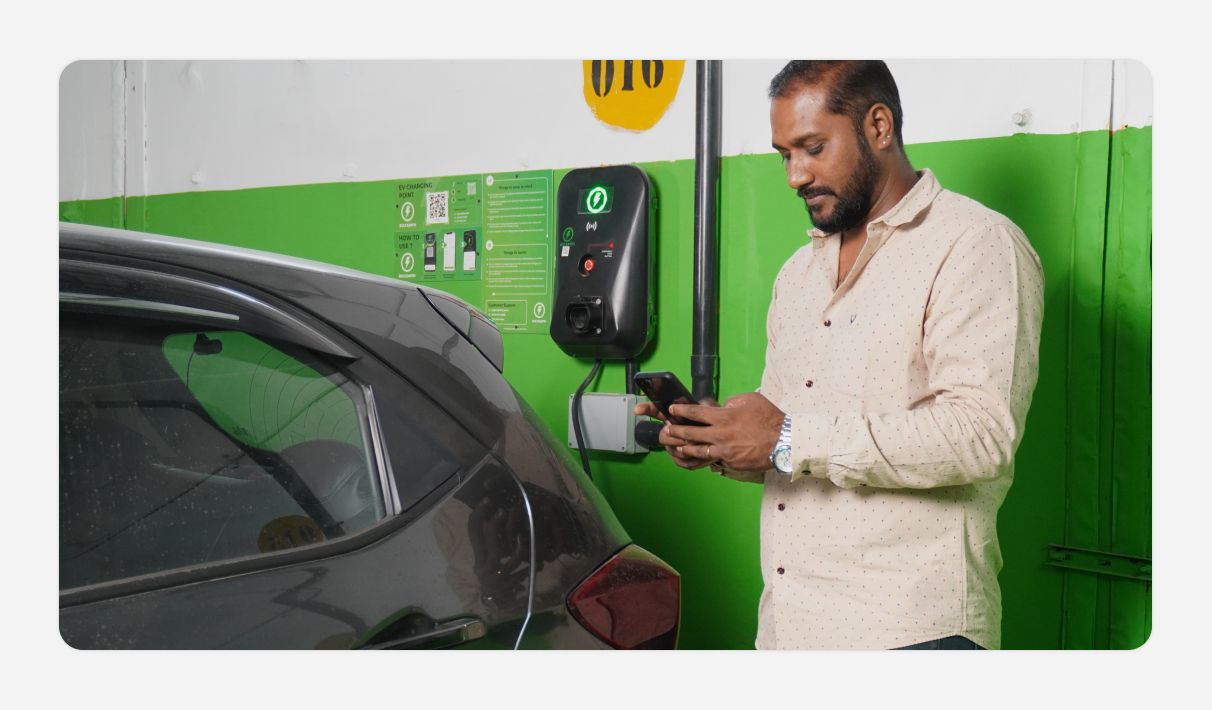
Now that we’ve outlined the strengths and limitations of AC and DC charging, the next question is: which should your business choose? The answer depends largely on how and where the charging will be used. In many cases, a combination of both may be ideal. Let’s look at typical scenarios and the most suitable charging solutions:
AC charging is well-suited for:
- Locations with long parking durations: If EVs are parked for extended periods, such as at offices where employees stay for 8 hours or malls where customers spend an afternoon, AC chargers are an excellent fit. In these cases, a slower charge is not a problem; the vehicle will have ample time to recharge.
- Overnight or residential charging: Apartment complexes, housing societies, or hotel parking areas often rely on AC charging because vehicles remain parked overnight. Installing AC points allows residents to charge their cars or two-wheelers each night at an affordable cost. Slow charging overnight is usually sufficient to replenish the daily driving range.
- Workplaces and destinations with long dwell times: Many offices and workplaces are adding AC chargers in their parking areas. Employees can plug in at the start of the workday and come back to a charged vehicle by evening. Similarly, places like multiplexes, supermarkets, hotels, and resorts, where visitors spend a few hours, can offer AC charging as a value-added amenity. These encourage EV drivers to visit and stay longer, benefiting the business.
- Cost-sensitive deployments: For businesses or institutions with limited budgets, AC chargers offer a cost-effective starting point. A small restaurant or shop might install an AC unit to attract EV owners without significant investment. Public projects also tend to deploy more AC units initially to maximize coverage. AC infrastructure enables affordable charging, albeit at slower speeds.
In these scenarios, the lower cost and simpler installation of AC chargers often outweigh the speed disadvantage. Many businesses find that a few hours of AC charging while customers or employees are on-site is enough to significantly top up or fully charge most EVs.
DC fast charging is better suited for:
- Highway stops and transit hubs: Highway charging stations or rest stops require DC fast chargers. EV drivers on long trips prefer spending 20-40 minutes charging, not hours. Fast chargers at petrol pumps or dedicated EV stations enable quick top-ups for long-distance travel. Similarly, transit hubs like intercity bus terminals or rail station parking lots benefit from DC fast chargers that allow travelers to recharge quickly before continuing their journey.
- Fleet operators with tight schedules: Commercial EV fleets, such as electric taxis, delivery vans, and buses, operate on strict timelines. DC charging helps vehicles return to service quickly. For example, an electric taxi can queue for a 30-minute fast charge between rides instead of being idle for hours. Bus depots also use fast chargers during layovers. Faster turnaround directly improves fleet utilization.
- Public charging hubs and commercial EV stations: If you are setting up a commercial EV charging station to serve multiple users, DC chargers are essential. They increase the number of vehicles charged per day, maximizing revenue. In today’s landscape, “fast charging = higher customer turnover”. A hub with multiple DC fast chargers can become a preferred refueling point. Offering DC charging also provides a competitive advantage by attracting drivers who need a quick top-up.
- “Future-proof” installations: Sites aiming to support the next generation of EVs should consider installing DC fast chargers. Newer EV models feature larger batteries and higher charging acceptance rates. Including DC infrastructure (or provisions for it) ensures readiness for future needs. For example, a tech campus might install one or two DC stations to support upcoming EV models or company fleet cars, even if current employee vehicles rely on AC. This signals a forward-looking approach and accommodates faster EVs.
For many businesses, a mix of AC and DC offers the best of both worlds. A large mall might install several AC chargers for shoppers staying a few hours, along with a couple of DC fast chargers for quick top-ups. Similarly, a fleet depot could use AC charging overnight to reduce energy costs and battery stress, while relying on DC chargers during the day for rapid turnarounds. Combining both types allows you to serve diverse needs efficiently.
The Indian Context: AC vs. DC on the Ground
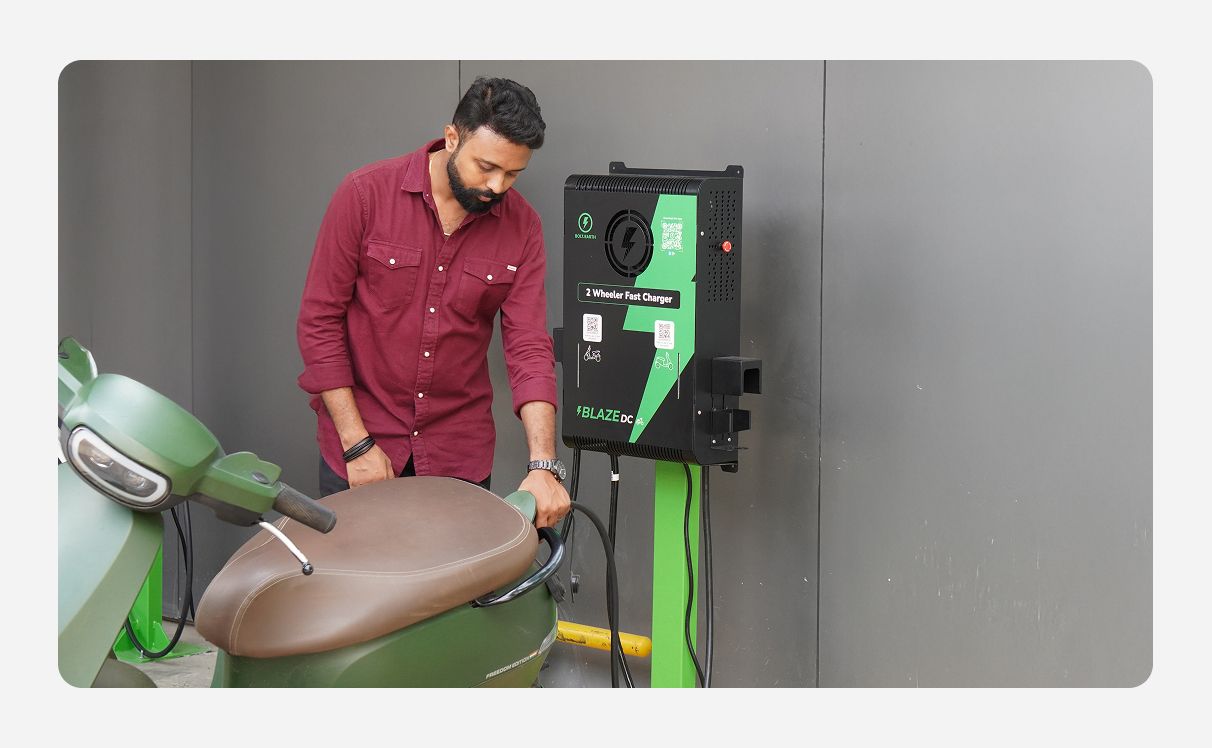
While the general principles of AC and DC charging apply globally, understanding the Indian EV market is crucial when making decisions:
- Vehicle charging capabilities: Unlike markets with widespread ultra-fast charging, many popular EV models in India have modest fast-charging capabilities. For example, mainstream electric cars like the Tata Nexon EV typically accept only 25–30 kW on DC fast charge. Even when plugged into a 60 kW or 120 kW DC charger, they charge at around 30 kW due to battery and thermal limits. A 30 kW DC charger can serve these vehicles just as effectively as higher-powered stations. Businesses should assess the vehicles likely to use their chargers; if most patrons drive such models, a 150 kW charger may not deliver its full benefit today. However, higher-end EVs and future EVs support faster rates (50 kW, 100 kW or more), and the market is gradually moving in that direction.
- Prevalence of two-wheelers and three-wheelers: India’s EV growth includes a significant share of two-wheelers and three-wheelers (scooters, bikes, rickshaws). These vehicles primarily use AC charging, often via a simple 3.3 kW or 15A plug, or battery swapping in the case of e-rickshaws. They lack DC fast-charge ports. If your business is located in an area frequented by two-wheelers (for example, a campus or shopping zone popular with e-scooters), installing multiple affordable AC charging points (or standard plug points with metering) may offer more value than a costly DC charger that these vehicles can’t use. For instance, an EV scooter might recharge in 1-2 hours on a 3 kW point, making DC charging unnecessary. Catering to this segment means focusing on accessible AC sockets and charging models like hourly or per-kWh fees.
- Standards and connectors in India: The Indian government has promoted standard connectors for interoperability. On the AC side, Type 2 (IEC 62196) is the standard for four-wheelers, while Bharat AC-001 (using 3-pin/IEC 60309 sockets) is used for light EVs at 3.3 kW. On the DC side, most cars use the CCS2 connector, which supports 25-350 kW. Bharat DC-001(with a proprietary GB/T connector) supports low-cost DC charging up to 15–30 kW, mainly for smaller cars and fleets. Why does this matter? If you’re installing fast chargers, CCS2 is the preferred standard for modern cars. Bharat DC-001 units(15 kW) are cheaper but limited to specific models like the Mahindra eVerito or the fleet variant of the Tata Tigor EV. Most commercial deployments now favor CCS2 for future-proofing. For AC chargers, Type-2 sockets or tethered cables will cover all cars, with adapter cables available for two-wheelers if needed.
- Current infrastructure mix: As of end-2024, most public chargers in India are still AC. This reflects cost considerations and the early phase of market growth. AC points are quicker and cheaper to deploy, helping build confidence among EV owners. Fast chargers are being rolled out along strategic corridors (e.g., every 25–50 km on highways) with government support. Only about one-third of public chargers are DC fast units, though this share is increasing. For a business, this means there may be gaps in fast-charging coverage you can help fill, potentially attracting customers. At the same time, many EV users expect destination charging to be AC-based.
- Government incentives and policies: The government is actively expanding charging infrastructure through initiatives like PM E-Drive, state EV policies, and zoning regulations. In some cities, commercial and residential buildings must allocate a percentage of parking for EV charging. Capital subsidies are also available in certain states, often with higher incentives for fast chargers. When planning your investment, check for subsidies, tax breaks, or public-private partnership opportunities, can significantly offset the cost of a DC charger or make AC installation nearly free. Also, electricity tariffs for EV charging vary by state. Some offer special EV tariffs lower than commercial rates. Navigating these policies can influence your decision (for instance, a subsidy on a 50 kW DC might make it as affordable as a 22 kW AC setup).
Overall, the Indian context calls for a pragmatic approach: start with the basics by deploying AC charging where it suffices, but plan for the future with DC fast charging as the EV ecosystem matures.
For many businesses, this means installing AC chargers now to meet current customer needs, while closely monitoring usage patterns and trends in EV adoption. As more EVs, particularly newer models, hit the road, you can scale up with DC fast chargers at strategic locations. The EV landscape in India is evolving rapidly, and adaptability is just as important as the initial choice of charger type.

Frequently Asked Questions
What is the difference between AC and DC charging for EVs?
AC charging uses the vehicle’s onboard charger to convert power from the grid, making it slower. DC charging converts power within the station and delivers it directly to the battery, enabling much faster charging.
Which type of charger is better for long trips or highway travel?
DC fast chargers are ideal for long trips or highway travel. They can recharge approximately 80% of the battery in 20-60 minutes. AC chargers are better suited for overnight stops or longer stays.
Do all electric vehicles support DC fast charging?
No. All EVs support AC charging, but only some, mainly modern four-wheelers, support DC fast charging. Two-wheelers and older models typically rely on AC or battery swapping. How much does it cost to install AC vs. DC EV chargers?
AC chargers cost ₹20,000–₹1,50,000 (but may vary depending on the power level and smart features). DC fast chargers range from ₹15–80 lakh, depending on power level and installation needs. Government subsidies may help offset these costs.
Should businesses install both AC and DC chargers?
It depends on your needs, but a mix of AC and DC chargers is ideal if your budget allows. AC chargers serve longer parking times and offer a low-cost option, while DC chargers provide quick charging for drivers on tight schedules. Many businesses start with AC chargers and add DC as demand grows. If you must choose one, pick AC chargers for longer stays and cost savings, or DC for fast turnaround and high traffic. Combining both offers flexibility and future readiness.
![Top EV Launches in India 2025: Cars, Scooters and 3-Wheelers [+Bolt.Earth Charger Compatibility]](https://bolt-wordpress.bolt.earth/wp-content/uploads/Top-EV-Launches-in-India-2025_-Cars-Scooters
-3-Wheelers-Bolt.Earth-Charger-Compatible.jpg)


